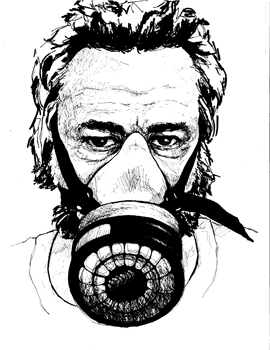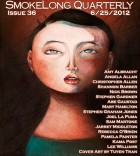Pamela, could you talk a little about the genesis of your story “Rehearsal for Dinner Party Theater.”
Sure. Several years ago, while traveling and wining and dining in Italy, I was intrigued by the way Italian couples argued. Their bickering seemed to have a contrapuntal lilt to it—perhaps I heard it that way because I had no idea what they were saying. This observation made me more aware of how couples argue when the stakes are just beginning to reveal themselves. And from there I went on to imagine how such arguments might even be a sort of performance. There are no dramatic gestures or events in this sort of situation, but rather the movement toward the final line that ends the story. And, of course, someone always gets to say the argument’s proverbial last word.
This story is a sterling example of compression, getting so much into a tight space. And the structure is challenging.
I discuss this structure in an essay that appeared in Tara Masih’s invaluable Field Guide to Writing Flash Fiction. Former student and now novelist, Jane Berentson, sent me an email of a review of a Vietnamese restaurant that appeared as “He said/She said,” and suggested it might make a good exercise. The structure reduces story to only dialogue, though it embraces both text and subtext of the given situation. A playwright friend said I am actually writing plays and recently sent me a draft of my story typed into script form. I really liked the look of it—the “saids” were deleted and the “he” and “she” are in the middle of the page. By now I’ve probably written six or seven stories using this structure, and I’ve been playing around with the possibility of doing an entire chapbook of them.
A chapbook of “He Said, She Said” stories sounds like a bold experiment, yet isn’t that what we need as writers: the ability to be bold, to try something new?
Yes, yes. You make me want to begin assembling that chapbook right this minute. And I do admire the experiments of, say, Raymond Queneau’s Exercises in Style, or Christian Bok’s Eunoia, Lydia Davis’s tiny stories. Bruce Holland Rogers’ story in questions. What Frances Lefkowitz does with voice.
What traits do you think writers should nurture in themselves in order to produce strong, authentic stories?
A ruthless trust in imagination and a devotion to the telling detail. Interesting that it is often easier to imagine the arc of a story than it is to come up with details that bring it alive. And I believe in keeping notebooks—all kinds, from the more cerebral ones similar to, say, those of Henry James, to the more esoteric kind such as the notebooks kept by Fitzgerald. He labeled one section “C—Conversation and Things Overheard” and another “H—descriptions of Humanity.”
Other advice. A writer is someone who reads—it’s almost as simple as that. Eudora Welty says it best. “Learning to write may be part of learning to read. For all I know, writing comes out of a superior devotion to reading.” And I’m delighted that more and more single-author collections of flash fiction are being published. I wish some press would do a series—publish collections that are longer than chapbooks. Meanwhile, publishers continue to bring out wide-ranging, flash fiction anthologies, and the internet is bristling with on-line journals and stunning stories.
What other kinds of things do you write? I know from personal experience how effective your non-fiction writing can be; do you have any more craft or motivation books on the schedule? Or perhaps a novel?
You’re probably referring to my co-authored textbook, What If? Writing Exercises for Fiction Writers. It includes a section titled “Sudden, Flash, Micro, Nano” with exercises and/or stories by Ron Carlson, James Thomas, Elizabeth Tallent, Luisa Valenzuela, among others. I’m particularly partial to a discussion of “The Interior Landscape of Your Characters.” The examples from novels and stories of a character using his or her imagination are dazzling: Margaret Atwood, Edward P. Jones, Toni Morrison, Kurt Vonnegut, Phillip Roth, Charles Baxter. Their characters think for themselves.
I’ve thought of doing a short book of exercises for the very short story, assignments I use in workshops at Emerson and the Fine Arts Work Center—but then I find myself writing stories instead. No novel. Never. I’m a story writer for good. And what a wild and wonderful Flash Fiction world we’re writing in.
Occasionally around the internet, I’ll come across a blog or a critique where someone has written “Pamela Painter says…” One comment I received myself from Randall Brown was “In working with Pamela Painter on my first collection, she wrote that I should “look for friction between stories—immediate dissimilarities that take you to a different world with the first sentence.”
And that is what Randall did in his superb collection, Mad to Live. In fact, my first appearance in an on-line journal was in Randall’s last issue of SmokeLong Quarterly. Assembling a collection can be challenging. When I’m in the process of doing a table of contents, I put the story titles on index cards and lay them out on a table in order to move them around, looking for dissimilarities that will make the reading of each story a different experience.
If you had just one thing to say to new writers, what would it be?
Discipline is a form of self respect. If you totally give yourself to your work and commit to staying with your story, gradually it will take on an energy and life of its own. When you take it up again, that work is now something apart from you, and it will repay your dedication with new energy for the next sentence, the next story.



 The core workshop of SmokeLong Fitness is all in writing, so you can take part from anywhere at anytime. We are excited about creating a supportive, consistent and structured environment for flash writers to work on their craft in a community. We are thrilled and proud to say that our workshop participants have won, placed, or been listed in every major flash competition. Community works.
The core workshop of SmokeLong Fitness is all in writing, so you can take part from anywhere at anytime. We are excited about creating a supportive, consistent and structured environment for flash writers to work on their craft in a community. We are thrilled and proud to say that our workshop participants have won, placed, or been listed in every major flash competition. Community works.